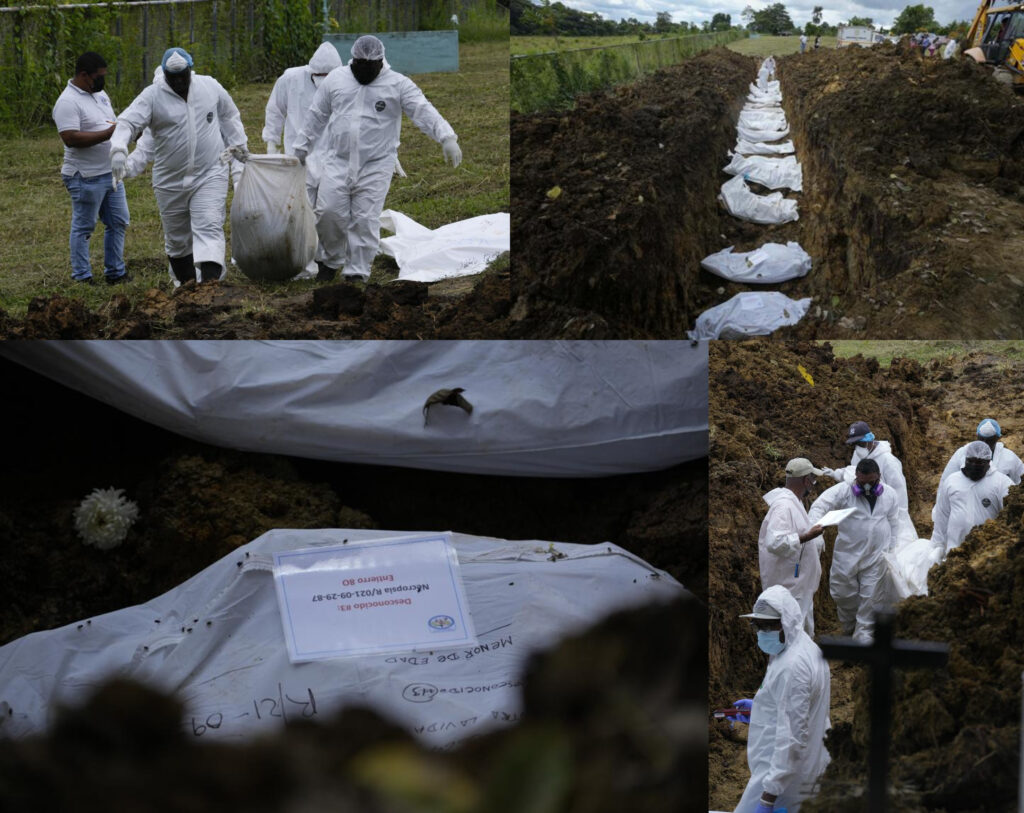AGUA FRIA — In an isolated cemetery in Panama’s Darien province, migrants who die crossing the most treacherous segment of their journey toward the United States are buried with a plasticized card containing what little information is available about them in case one day someone comes looking.
On a recent afternoon, white-suited workers laid to rest 15 sets of remains in a long trench at the back of the cemetery. A local priest standing at the head of the trench with a candle, crucifix and flowers performed a simple ceremony. On the white body bags were handwritten clues: “Unknown in Bajo Grande,” “Unknown in Turquesa river,” and “Unknown #3, Minor.”
So far this year, Panama has recovered at least 50 sets of remains from migrants crossing the Darien Gap, a number officials believe is only a portion of those who died in the dense, lawless jungle. In recent years, 20 to 30 bodies on average have been recovered annually, but this year Panamanian authorities say more than 90,000 migrants — mostly Haitians — have crossed the Darien Gap from Colombia and the body count reflects that surging migration.
“That number is a minimum quantity of the human remains there are along the whole route,” said José Vicente Pachar, director of Panama’s Forensic Sciences Institute. “Many of them die of natural causes, for example, a heart attack; they fall and no one attends to them. They stay there or they’re assaulted or the water’s current comes and takes the bodies that end up floating along the river’s edge.” Snake bites are also common.
“Right now we don’t have a way to investigate like we want to with international support, to go on the trails, the paths, because all the descriptions and statements (say) there are human remains,” Pachar said.
Agents of Panama’s National Border Service help recover bodies, sometimes extracting them with helicopters, along with investigators from the Darien prosecutor’s office.
But the recovery is only the first challenge facing investigators.
The bodies are often badly decomposed in the high-humidity environment or partially eaten by animals. Those who may have witnessed a death, being migrants themselves, keep going and are not around to assist in identifications. And most of the bodies are without identification, it having been stolen or lost.
Julio Vergara, Darien province’s top prosecutor, says that even when migrants report a death, “when we do the recovery and are going to corroborate the facts, the migrants who reported it have unfortunately continued on their route.” He said that of the cases he has opened this year, five Haitians, two Cubans and a Brazilian have been identified. Four of the victims were children.
Haitians made up the majority of the 15,000 migrants who camped for days in Del Rio, Texas, last month beside a border bridge. The U.S. has deported thousands of them to Haiti.
In Panama, much of the identification work falls to Pachar’s staff at the morgue in Panama City.
If possible, they fingerprint the victims, create dental records and try to determine a cause of death. All of that information is entered into a database.
“It is a laborious process because generally the bodies are in a putrefaction stage, many individual characteristics have been lost,” Pachar said.
The burial of 15 victims in Agua Fria followed a similar ceremony in the same cemetery weeks earlier. In that case, six sets of remains were interred.
Pachar said the burials are necessary not only out of respect for the victims, but because morgues across Darien need to open space for new victims.
“If someone comes later who wants to take the remains of their loved one, we have a way to tell them: ‘Here they are,’” Pachar said.
Vergara said that so far a family had claimed the body of a Cuban migrant and relatives of another non-Latin American migrant confirmed the identity so the person could be buried in Panama according to the family’s customs and religious beliefs.
Among the most recent burials was a fetus that Vergara said a Haitian woman had delivered to authorities in a bag. She told them she had miscarried when she fell during the crossing, the prosecutor said.
Migrants have been buried in at least a half-dozen other communities in Darien. The burials have caused resentment in some Indigenous communities where locals do not want the migrants buried in their cemeteries. There had been rumblings in Agua Fria as well, so a local leader asked Rev. Delgado Diamante, who performed the burial ceremony, to address the matter in his homily during Mass at the local church.
The day after the burials, farther down the pot-holed highway that leads deeper into Darien, more than 800 migrants — mostly Haitian — got off boats in the Chucunaque River that had carried them out of the jungle and joined nearly 300 already waiting in a migrant camp. Many boarded government buses that would drive them across Panama to a camp near the border with Costa Rica.
Iseris Shily, a 34-year-old from Haiti, remained shaken by his ordeal in Darien Gap. He and his wife, Siberisse Evanette, had traveled to Chile in 2017 and left there this year hoping to make it to the United States.
Shily said his wife had a miscarriage during the crossing and was hospitalized Friday with bleeding.
“She almost died,” he said. “We were like six days in the jungle without water, without food, because everything we had brought was gone.”
He said they had been robbed when approaching the first town, then threatened with death because they said he couldn’t pass without paying. “Now I don’t have money to continue on my way.”
Shily had called relatives in the U.S. before entering the jungle. On Friday, he wanted to let them know they had made it, but his cellphone was dead.
“I remember a lot of things. I didn’t want to talk about that,” Shily said. “I saw how six people died in front of me in the river. This tragedy is very difficult. It is not an adventure I want to relive.”



